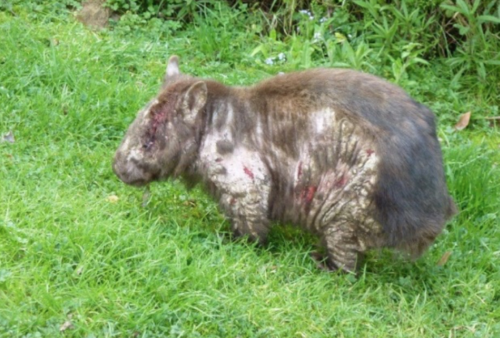Mange & Disease
Mange is one of the biggest killers of wombats. The mange mite buries itself under the wombat’s skin triggering extreme itchiness which makes the wombat scratch, causing open wounds and scabs to form. These become infected, the wombat loses condition, becomes dehydrated, malnourished and slowly dies. The good news is, it can be treated. In this section, you can learn more about how to identify mange and what to do if you come across a wombat with mange.
If you have any questions regarding mange or would like to speak to one of our experts, please contact us on mange@wombatprotection.org.au
APVMA approved PERMITs
Compare the three available permits
Responses were invited to the fact sheets, they are discussed in the Bravecto position statement below.
The Wombat Protection Society of Australia currently hold two Australian Pesticides and Veterinary Medicine Authority (APVMA) Permits to treat wombats with mange using the chemical Moxidectin.
Permit PER90094 Moxidectin/Wombats/Sarcoptes Mange has been issued to treat wombats with moderate to severe mange using a “pole and scoop device”.
Permit PER89040 is suitable for prophylactic population treatment.
See how to apply Cydectin/Moxidectin using pole and scoop.
This method of application ensures the Cydectin/moxidectin reaches the targeted area. Start at the neck and continue along the spine, only applying on healthy skin avoiding any scabs, open wound and eyes. The wombats rump/plate has a poorer absorption rate and should be avoided if possible.
This wombat’s fur is growing back nicely after being treated for mange.
what is Mange and how to treat it
Mange is one of the biggest threats to Australian wombats. It can wipe out isolated colonies in just a few years. It is geographically widespread and affects thousands of animals. Marie Wynan, Director at WPSA, takes a look at sarcoptic mange and how it can be treated.
Mange – Frequently asked questions
Here we tackle some questions you may have when treating mange. Should you have have any further questions or concerns not covered in our document, please contact us at mange@wombatprotection.org.au
treating mange using moxidectin manual
Understanding dose rates and pharmacokinetics including case studies for Bare-nosed Wombats. This manual is still to be updated. The recent published research is:
https://doi.org/10.1016/j.vprsr.2024.101074
http://dx.doi.org/10.1002/vms3.70089
https://doi.org/10.1016/j.jchromb.2023.123988
Updated May 2025
great news for wombats in nsw
WPSA has a Biodiversity Conservation License via NSW NPWS. This BCL is for the “in situ treatment of free-living mange affected wombats”.
HOW LONG DO MANGE MITES SURVIVE?
Mange mites can survive between two days and three weeks after a host has died depending on relative humidity and temperature.
Learn how quickly these mites can infest and how they may effect other mammals.
Surviving Mange, One Joey’s story
Read of one wombat joey’s story saved from the slow, painful death that can be caused by mange.
Experts call for a National Plan to Help Save Wombats from Mange
The incoming environment minister has a clear opportunity to tackle this debilitating disease. Wildlife carers and conservationists want to make the issue of mange a priority.
The Guardian, by Alexandra Spring
MANGE treatment guidelines
The Wombat Protection Society has been working for many years with groups and individuals to eradicate mange throughout Australia.
This download booklet is for people who want to develop a treatment program in their area.
historic Mange treatment by a landowner
Wombats in Australia face many challenges such as drought and the destruction of their habitat. However, sarcoptic mange can be one of the most painful ways for a wombat to die. This is a record of an historic mange treatment one landowner carried out taking an innovative approach to treating this horrible disease. Research has now improved this method. Updated 24th January 2024
WOMBAT BURROW FLAP
One of the most effective ways of treating mange is placing a flap at the wombat’s burrow entrance. This will ensure a wombat gets the regular doses needed throughout the treatment period.
Designed with a 3D printed medication delivery container. It has sloped sides for better delivery and a roof with a small “gutter” to keep moisture from mixing with the medication. The perspex is less intrusive and better accepted by the wombat. All corners are slightly rounded to prevent sharp edges
Cydectin Mange treatment medication
WPSA’s policy on supplying mange treatment medication to wildlife groups and individuals has changed and an updated policy will be updated soon. 24th January 2024
What to expect when treating mange
When treating a wombat for mange, it will look worse before it gets better. As scabs fall off, new pink skin is exposed making the wombat look sickly. Don’t despair! Your treatment is working and eventually the wombat will grow a healthy new coat of fur.













